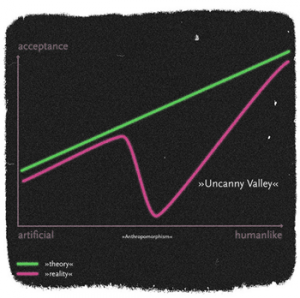Although the concept of the uncanny valley has been around since 1970, it has only become a widely encountered problem in the past five years. The term uncanny valley was coined by robotocist Masahiro Mori, and his was the first industry where questions of culture, psychology and humans interaction with technology became an issue. In the past five years other practitioners, including creators of digital images in gaming and simulations, have needed to grapple with this concept.

The Uncanny Valley. Image Sourced Flickr - fabiantheblind/fabiantheblind 4th inc. Licence: cc – Attribution 2.0 generic
The need to seriously address the uncanny valley is a milestone in technological development. We have suddenly arrived at the point where technical issues are no longer a barrier to further development. The issues we now encounter are psychological and cultural; they are about us. From robotics to the digital interfaces we prefer to use, culture, psychology and aesthetics are becoming powerful concerns, and these concerns are being factored into investment decisions. Facebook’s business models are driven by these factors, PARC Xerox are employing anthropologists, Yahoo are employing psychologists and robotics labs are hiring artists.
In this uncharted territory, the issues that drive art and culture are the same as those that drive economic and technological development. This future territory will require the capacity to synthesise culture, psychology and aesthetics into a new creative vision. The people who traditionally have these skills are called artists.
For the past ten years ANAT has been placing artists into scientific research labs. The first of many ventures into this future was as an Industry Partner on Mari Velonaki’s ARC Linkage research project with the Australian Centre for Field Robotics. This project led to Velonaki co-founding the Centre for Social Robotics, which seeks “to understand what is possible in human-machine interaction”. Artists are redefining what constitutes an artistic career and in the process having a deep and pervasive impact on society, technology and business.
The change at the professional level of creativity is mirrored by the growth of creative cultural communication happening in the general community. This digital folk art can range from beautiful physics simulations to fan videos on Youtube and even commentary on these fan videos, but none of these are considered art in the traditional artworld sense. We have been given ever improving creative tools and platforms and, in societies that underutilise skilled, educated and creative people, we are using this “cognitive surplus” in an exponential demonstration of community and cultural participation. In so doing, people are exhibiting a deep desire to actively participate as citizens in society.
Web-based manufacturing companies like Shapeways and Ponoko are using crowdsourcing and co-creation to utilise this cognitive surplus. Their use of CNC and 3d printing is allowing people to transcend the virtual and the real worlds; creating the real world as they want it. This, in turn, is cultivating a new world of micro, on-demand manufacturing and business models that no longer favour traditional industrial economies of scale. The barriers to entry into manufacturing are crashing and citizens can directly influence the type of industries and products they want. This era of co-creation leaves behind the concept of the passive consumer and ushers in a new era of entrepreneurial citizenship, where we take on our democratic responsibilities through creating the products, systems and communities that we want to see without having to lobby or wait for governments and corporations to answer our needs.
We are entering an era where creativity and culture will be the core tools used by citizens to act democratically through their daily lives. When we lose the difference between creators and consumers we find a directness between citizens that has not been possible. The need to think about the uncanny valley means culture, psychology and aesthetics will be at the heart of the next wave of technology and business development and we are only just seeing the beginning of these new systems and tools.
Gavin Artz
This article is adapted from a talk given by Gavin Artz as a part of The Australian Centre for Social Innovation (TACSI) Blue Sky Sessions program.
http://www.tacsi.org.au/blue-sky-sessions/
Watch More
 This work is licensed under a Creative Commons Attribution-NonCommercial-ShareAlike 3.0 Australia.
This work is licensed under a Creative Commons Attribution-NonCommercial-ShareAlike 3.0 Australia.







[...] Gavin Artz talking about art and technology as drivers for social change and ANAT Intern Eva Sprenkelder gives us a preview of ANAT’s DomeLab 2010 Project [...]